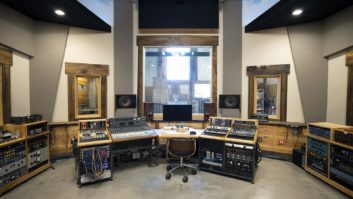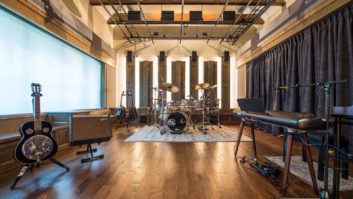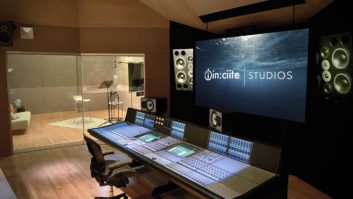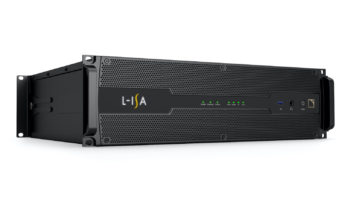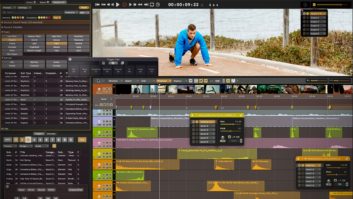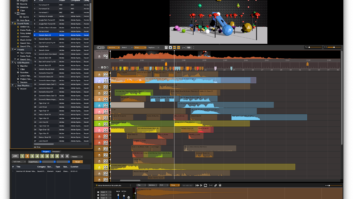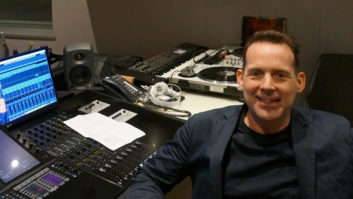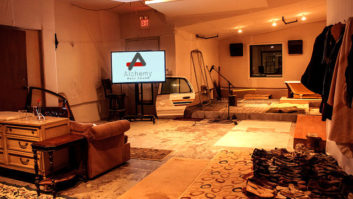
“Sound-for-picture” has traditionally meant audio-for-film, television and video; think of all our usual needs and considerations in pursuit of sonic quality now merged with the needs of counterparts like script, dialog, scoring, actors, direction, cameras, noisy sets (if any at all), voice-overs, ADR, natural sound, dailies, constantly evolving edits, live broadcasts, capturing audio on the run and last-minute changes right up until the 11th hour (and 59 minutes).
New vistas push the envelope even further with virtual reality, 3-D audio, immersive audio, interactive audio, videogames, Web audio and live Webcasting, all catching on like wildfire. The tools and the techniques from all these various avenues are merging, allowing new methodologies, new workflows and new expectations.
Many of the tools of the trade are shared with music production and some are ubiquitous—for example, Avid’s Pro Tools and the company’s flagship S6 control surface. Pro Tools remains the eminent DAW on the market and Avid’s control surfaces (S6, S3, Artist Control and C24) are seen as the perfect companion in countless post houses, studios and film mixing stages, all while Avid’s Media Composer grows in video editing popularity.
It’s a rapidly evolving digital world and there are new platforms, new technologies and new attention to ergonomics that are finding once difficult tasks now rudimentary, the once impossible now doable and the once inconceivable now attainable.
Here are some examples from the cutting edge of sound for picture.
8DIO Majestica Kontakt Instrument
Like the name implies, Majestica is all about big, as in a big 240-piece orchestra. According to 8DIO, that’s the biggest ever sampled, with 100 strings, 60 brass instruments, 60 woodwinds and 20 percussion instruments! Kontakt Version 5.3 or later is required for playback, and the collection is nearly 24 GB in size.
And what a collection it is. The sheer number of articulations, figures and voicings is staggering, with total control of finer details like round robins and individual tunings. Sounds were captured at 96 kHz with three mic positions (Mixed, Decca Tree and Far) for extensive mix flexibility. The all-crucial UI was built from scratch with more than 35,000 lines of code, so control is easy and streamlined. This includes a new advanced articulation browser, arpeggiator and polyphonic step sequencer. Price: $599 direct.

Coleman Audio SR7.1MKII Surround Monitor Controller
Glenn Coleman doesn’t mess around when it comes to the construction of his namesake switchers, controllers and routers. Stepped output attenuators, firm switches, tight pots, no-frills designs and proper components are found in all of Coleman’s products. As such, I’ve rarely visited post-production pros that don’t have a Coleman or two in their monitoring chain, especially if they work in surround.
The newly updated SR7.1mkII continues all those positive trends in the company’s flagship controller. Eight channels of input and output are found on DB25 connectors with mutes and level trims on all inputs. There are easy fold-downs with 7.1 inputs summing down to 5.1, stereo, or mono, and mutes for the L/R. There are even trims for the mono and stereo sums, so this box can get your surround mixes properly calibrated for delivery, especially if paired with Coleman’s SMP5.1 surround VU meter. Price: $1,940 street.

iZotope RX5 Advanced Audio Editor
It’s no secret that RX5 Advanced is one seriously effective program and wildly popular, too. It successfully cleans up audio problems of seemingly all varieties (plosives, sibilance, hum, clicks, clipping, excessive verb, unmatched ambience, wild levels, etc.). What’s most interesting is that Advanced keeps on advancing, with new features as well as workflow efficiencies.
New modules De-Plosive, De-Reverb and Leveler are all eponymous and obvious, while the similar Ambience Match is now accessible within Pro Tools via AudioSuite.
The new Instant Process tool doesn’t require much description but one can easily see the advantages to simply highlighting a selection and having your pre-selected process happen immediately. Equally helpful are Module Chains, allowing a series of processes to be engaged with a single click—ideal for those most difficult of repetitive jobs.
Having recently completed an audiobook—which is, actually, the antithesis to sound-for-picture—I found RX5 Advanced to be indispensable for taming clicks (including actual sonic ones, those accentuated by a large diaphragm condenser mic and digitally induced ones), removing extraneous noise and removing plosives. For music mastering I find myself leaning on De-Click and De-Clip to remove the very worst moments from semi-pro mixes. De-Noise is the trickiest of all the modules to use, but when it saves the day (as it often does for dirty guitar tracks or client-submitted vocals), it can elicit gasps from relieved clients: all useful functions, if not lifesavers, whether accompanied by picture or not.
Price: $349 direct, with RX5 Advanced at $1,199 which includes the Insight metering plug-in (my favorite), a $499 value.

MOTU Digital Performer 9.1 DAW
I’ve always considered DP to be quite the user-friendly platform—I’ve been on it since 1999—and I’m far from alone. It seems that DP is the popular choice among composers, especially for those writing cues for film and TV, and it features a slew of “make this tough job easier” features.
You can import QuickTime video into the session and it shares the timeline with your audio tracks for quick and easy sync. New to DP9, MOTU’s SMPTE-Z timecode generator can create timecode from your timeline, allowing an easy solution to what would be jam synching. The new PreGen engine renders output from plug-ins and virtual instruments, allowing more instances of each. The new MegaSynth turns guitars (or any audio, really) into synths, allowing six-string composers like myself much more creative flexing.
Veteran film and TV composer, producer and longtime DP user David Das confirms: “The improvements in the PreGen engine are pretty amazing, specifically concerning virtual instruments. It’s pretty much changed the scope of what I’ve been able to accomplish with VIs, now that I can have more of them running at once. And MusicXML export has made it a lot easier to get MIDI from DP into a dedicated notation program.”
Price: $499, competing product upgrade $395 direct from MOTU, $195 upgrade from previous DP versions.

Sound Devices CL-12 Linear Fader Controller
It should come as no surprise that Sound Devices is considered a leader when it comes to grabbing critical audio on-location, on-set or “run ’n’ gun” ENG work. It’s in no small part based on the company’s popular portable recorders, or mixers, but even more focused on their combo mixer/recorders, which paired with DC-power make the whole world your soundstage.
Anyone employing a Sound Devices combo 633, 664 or 688 on their production cart could appreciate the CL-12. It provides those with 12 faders, a three-band parametric EQ for each of the 12 inputs, quick access to wireless data with SuperSlot, auto-mix monitoring with MixAssist and all with only a USB A-to-B and a TRS ¼-inch to connect the CL-12, making the dreaded-yet-inevitable jumps back and forth between carting and bagging/ENG a lot more tolerable.
The CL-12 accepts a USB QWERTY keyboard for quick data entry, remote control via third-party apps and has a jack for powering a USB lamp. Lest you think this is just hardware for the trenches, check out the CL-12 studio version with Penny & Giles faders and sides made of maple/mahogany.
Jamie Gamble reports that the CL-12 is a necessity for live shoots: “When I was on set of my recent projects, Maron and Shut Eye, Sound Devices’ CL-12 linear fader controller was a must-have because it made recording and mixing with the 688 a breeze. It features tactile controls, sturdy design, illuminated buttons and LED metering: all great features when working in the field. It also has additional ports, which allow me to connect a USB keyboard at any point. This is great for inputting metadata on the fly helping to provide a more detailed end result to post.”
Price: $1,995 (black), $2,995 (studio version).

Synchro Arts Revoice Pro Version 3.2
We’re all concerned with speed and efficiency, but for dialog editors, efficiency is Job One. Whether you’re cutting dailies for film, chopping dialog to match last-minute picture edits or replacing voice-over work for television, you’ve got to move fast, get it right the first time and avoid being the weakest link. Revoice Pro Version 3.2 brings top audio quality to its unique vocal manipulation process and provides workflow enhancements that are just shy of miraculous.
The pitch, timing, vibrato and inflection of a guide track is captured by APT (Audio Performance Transfer process) and is used to adjust the newly overdubbed audio and fit it into the production seamlessly—and quickly, too, with the ability to automate the processing; one can always choose manual for specific details. Such power is indeed useful for music production, too (for easy doubles and/or harmonies) but for sound-for-picture, we’re really talking “game-changer.” For example, have the director lay down the guide vocal with specific hits, inflections and timing, then conform the VO to match the guide: you’ve just removed considerable guesswork and the efforts of an assistant producer!
Veteran dialog, ADR and sound editor Renee Tondelli had this to say about her workflow: “Frequently I am shooting ADR at the end of the mix and need to get it in quickly. With Revoice Pro, I am able to sync ADR seamlessly with incredible accuracy in a moment. I also rely on the pitch feature so the performances can match production dialog perfectly.”
Available direct for $599 with numerous discounts available for upgrade and a three-month rental is offered for $179.

Vienna Symphonic Library Vienna Ensemble Pro 6
Vienna Symphonic is quite well known for its sound libraries and hugely realistic orchestral re-creations, but the new Ensemble Pro 6 addresses workflow necessities in a uniquely powerful way. This hosting and mixing application enables a computer network with both Macs and PCs, interconnected with Ethernet cable, to host Vienna Instruments libraries as well as third party 32- and 64-bit VST/AU instruments and plug-ins and—if integrated with Vienna MIR Pro—to mix in up to 7.1 surround. Included is the Epic Orchestra sample pack enabling “right-out-of-the-gate” utility and ability.
Even one-computer composers might take a look at Pro 6 for the new Preserve feature that keeps all your sample libraries, sounds and plug-ins loaded even as users switch between projects. It reduces load times enough for power users to take on a new hobby—figuratively, of course. Price: $371 direct from Vienna Symphonic Library.

Yamaha NUAGE Version 1.8 Audio Mixing System
It could be said that the future of professional audio-for-video production arguably lies in immersive sound for virtual reality, videogames and film/TV, and such endeavors are indeed complicated. So, efficiencies of workflow and consistent performance are necessities. Steinberg through NUAGE seeks to address such issues with a complete and integrated system offering synergistic hyper-efficiency. The core is Nuendo/Cubase software (with a PT Bridge offered for Avid’s Pro Tools), controlled via NUAGE Faders and Master Controllers, joining the analog world via a series of NUAGE interfaces, all communicating on a Dante-equipped network and achieving low latency with a PCI-Express based Dante Accelerator card.
Yamaha reports its new Version 1.8 software fully supports Nuendo’s VST Multi Panner 3D, completely recreating the GUI environment on the NUAGE Master touch screen for Dolby Atmos immersive sound production.
Three-decade veteran Michelle Garuik, who specializes in mixing and sound design for Grind Music & Sound, Inc. in Los Angeles, says, “NUAGE has sped up my workflow by 50 percent, which has allowed me to keep up with ever-shorter delivery deadlines. The system allows you multiple ways to perform tasks, so you can customize it to how you like to work. You have the choice of moving object pans around by dragging the placement ball with the touchscreen in the box view or using the corresponding knobs under the touchscreen. We will be adding another NUAGE/Nuendo system to our new studio being built next spring.”
Price: $11,499 MSRP (Nuage Master center section), $12,999 MSRP (Nuage Fader, 16 channels).

Zaxcom ZHD High Density Wireless
Glenn Sanders founded Zaxcom back in 1986 and has continually pushed the location recordist’s envelope, evidenced in the company’s Deva portable recorders, mixers, control surfaces and digitally modulated wireless systems. In April of this year, the company launched a new line—ZHD High Density Wireless—and the features go well beyond convenience.
TRXLA3 and TRXLT3 transmitters both utilize extremely narrow 50kHz bandwidths, as close as only 100kHz apart, allowing 60 channels of ZHD to operate in a standard 6MHz American TV channel slot. The audio is fully encrypted and there is internal backup recording right in the belt pack (with timecode), Neverclip level protection and Zaxnet networking (including Zaxnet QC Audio), allowing remote control of gain levels, power consumption and the ability to mic-check without going back to your cart. The transmitters will play back in timecode sync, allowing multitrack playback and re-records if RF is polluted or the record deck fails.
Prices: $1,775 to $2,075 (TRXLA3 and TRXLT3 transmitters are offered in numerous configurations).
Rob Tavaglione has owned and operated Catalyst Recording in Charlotte, North Carolina, since 1992 and is a freelance journalist for the pro audio industry. twitter.com/RobTavaglione.
